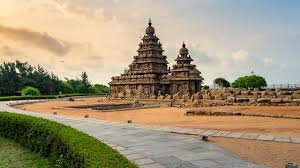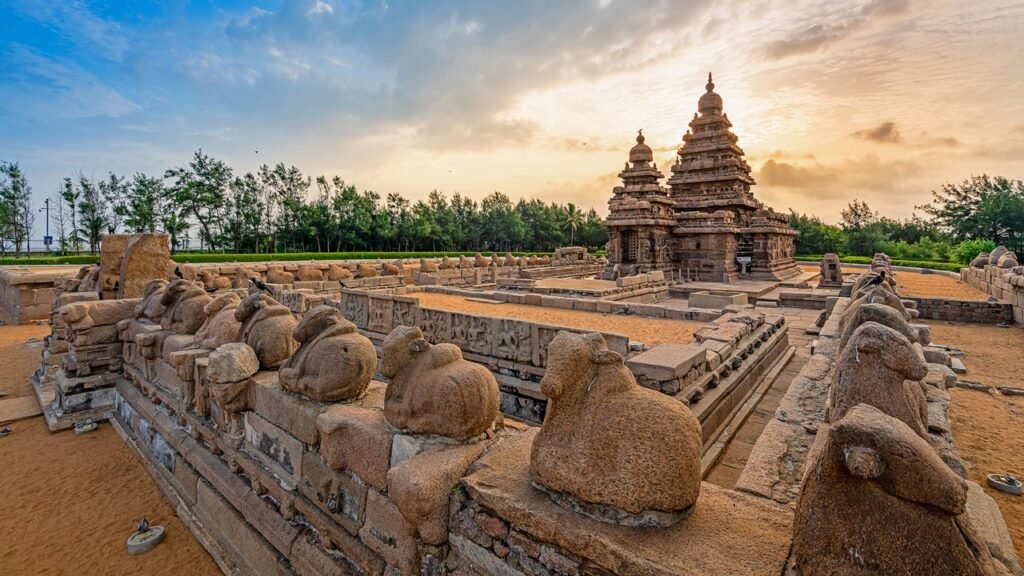The Shore Temple in Mahabalipuram, Tamil Nadu, stands as one of India’s oldest and most celebrated stone temples, a testament to the architectural finesse and spiritual legacy of the Pallava dynasty. Set against the stunning backdrop of the Bay of Bengal, this UNESCO World Heritage Site blends history, legend, devotion, and artistry, making it a must-visit cultural landmark.
Location and How to Reach
- Geography: The Shore Temple is located in Mahabalipuram (Mamallapuram), about 60 km south of Chennai, Tamil Nadu, India.
- Nearby Transport:
- Travel Tips: Best explored during November to February for pleasant weather; open daily from 6 AM to 6 PM.
Key Details:
- Children below 15 enter free; recommended to visit early for fewer crowds
- Entry ticket can be used for other monuments in Mahabalipuram.
- Ticket purchase and validation are at the main gate; single entry per ticket.
- Carry hats or sunscreen for the day visit due to sun exposure.
Historical Significance of the Shore Temple
Initially constructed in the early 8th century during the reign of King Narasimhavarman II, also known as Rajasimha, the Shore Temple forms part of the famed Seven Pagodas, although only one remains above water today. The legendary ensemble fascinated explorers like Marco Polo, who popularized the myth of submerged temples. The devastating tsunami in 2004 revealed several lost structures, renewing archaeological interest and confirming local legends.
This ancient port city boasted maritime wealth, and the temple itself served as a vital landmark for seafarers navigating India’s eastern coast. The spiritual, commercial, and cultural layers of Mahabalipuram are woven into every stone of this historic complex.
Architectural Brilliance
Built from massive blocks of locally quarried granite, the Shore Temple complex features three shrines arranged on a single platform: two dedicated to Shiva and one to Vishnu. Its main pyramidal structure rises to 60 feet and reflects classic Dravidian architectural elements such as stepped stories, ornate shikharas, and finely sculpted motifs of Nandi and mythical lions.
Notably, the temple blends Shaivism and Vaishnavism, highlighting religious inclusivity of the Pallava period. The site also features exquisite bas-reliefs, Somaskanda panels, and the unique miniature shrine dedicated to the boar incarnation of Vishnu, adding to its spiritual and artistic richness.
Spiritual and Cultural Impact
The Shore Temple remains an active pilgrimage site, drawing devotees and tourists alike to its dual sanctums of Shiva and Vishnu. Local lore suggests an association with Lord Rama and other legends of Hindu mythology, making it a venue for regular rituals, festivals, and community gatherings.
The annual Mamallapuram Indian Dance Festival held against the backdrop of the temple showcases classical forms like Bharatanatyam, Kathak, and Odissi, adding vibrant cultural flavor to its spiritual ambiance.
Tourism and Revenue Generation
With its iconic status and proximity to Chennai, the Shore Temple is one of the most visited monuments in India, with annual footfall exceeding 1.2 million and foreign visitor statistics that rival even the Taj Mahal. Tamil Nadu’s overall tourism revenue saw a fivefold increase, energized by attractions like Mahabalipuram’s Shore Temple. Entry fees for Indian and foreign visitors, as well as camera charges, sustain maintenance and conservation efforts.
Recent projects, such as the TTDC’s ‘Immersive Experience at the Shore Temple,’ have allocated Rs 24.72 crore to enhance facilities and accessibility, promising to further boost visitor experience and economic impact.

Economic and Social Influence
The Shore Temple’s annual footfall drives local hospitality, retail, and transport sectors, creating thousands of jobs and supporting artisans, guides, and small businesses. Enhanced conservation and “green energy” initiatives have made it India’s first green energy archaeological site, further cementing its status as a world leader in sustainable tourism.
Conservation and Modern Facelift About Us
Conservation has been a top priority due to its exposure to wind and sea, with the Archaeological Survey of India (ASI) employing modern techniques to preserve its grandeur. The recent Immersive Experience project is set to deliver infrastructure improvements, digital experiences, and enhanced tourist amenities while maintaining the temple’s integrity and environmental harmony.
FAQs About Shore Temple
What is the Shore Temple’s architectural style?
It follows Dravidian temple architecture, notable for its stepped pyramidal tower, sculpted granite base, and intricate carvings.
Why is it called the Shore Temple?
Because it is situated directly on the Bay of Bengal’s coast, overlooking the sea.
Who built the Shore Temple?
The Pallava king Narasimhavarman II (Rajasimha) commissioned the temple in the early 8th century.
Is there any entry fee and what are the timings?
Yes, Rs. 10 for Indians, Rs. 340 for foreigners. Camera charges are extra. Timings are 6 AM to 6 PM.
Why is it a UNESCO World Heritage Site?
For its exceptional historical, architectural, and cultural significance, and its role in ancient maritime history.
What festivals are celebrated at the Shore Temple?
The major event is the annual Mamallapuram Indian Dance Festival featuring classical Indian performances.
How did the 2004 tsunami affect the Shore Temple?
The temple survived with minimal damage, and the event revealed submerged ruins and lion sculptures, fueling renewed archaeological interest.
How many temples originally existed in this area?
Local legend and travelers report Seven Pagodas, but only one, the Shore Temple, remains above water today.
